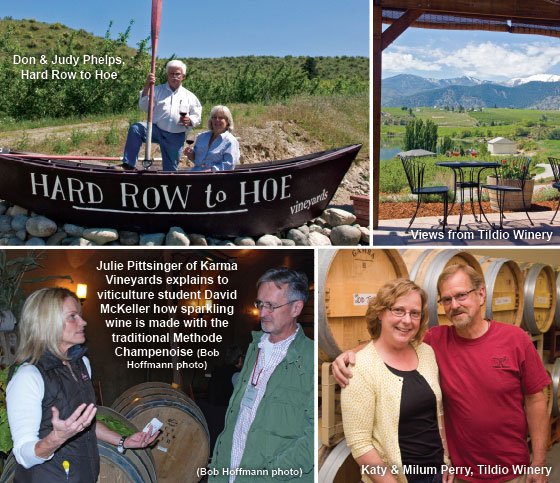“You need a lifetime or more to learn everything about winemaking,” said Judy Phelps, standing among plastic tubs and oak casks containing grapes at various stages of becoming wine. Phelps, winemaker at Hard Row to Hoe Vineyards in Chelan, Washington, was sharing some of her life’s enological experience.
And Lana Getubig, a 2009 graduate of WSU’s online viticulture professional certificate program, was drinking it up. She and other students and alumni of the viticulture and enology certificate programs took a weekend in November to further their education, traversing the wine country around Lake Chelan in north-central Washington. The tour is one of many opportunities offered by WSU for grape growers and winemakers—veteran, novice, and aspirational alike—to network and share knowledge.
Participants were able to ask established professionals about seemingly mundane details that could have significant repercussions. One notable detail at Hard Row to Hoe was the floor of the wine cellar. A thin, shiny epoxy-and-sand mixture coated the slab on which the building sat. “Grape juice and wine eat concrete,” explained Phelps. The special coating provides both protection to the concrete floor and traction for workers.
Judy’s husband, Don, took the group to the vineyard for insights on his area of expertise. “The slopes of our vineyard help cold air pass through without settling,” he said. The leaves of his vines had lost most of their green pigmentation and, although faded to a muted yellow, remained undamaged by the November cold. He pointed, by way of contrast, to a neighbor’s vineyard on a flat spot at the bottom of a slope. That site allowed cold air to pool, and the leaves there were coated with a layer of frost. Poor site selection shortened the neighbor’s growing season and negatively impacted the quality of grapes.
Once a vineyard site is selected, young vines need proper care, Phelps told the students. “We often hear that grape vines need to struggle, but that doesn’t apply to young vines. They need water to become established.”
After visiting the tasting room, the group continued on to visit other wine producers, including Tildio Winery, with its sweeping view of Roses Lake and the North Cascades Wilderness. Katy and Milum Perry purchased the property in 2001. Katy already had considerable experience in winemaking, including stints at Robert Mondavi and Chateau Ste. Michelle.
Their fermentation room, with its stainless steel tanks, was heated to 60 degrees Fahrenheit for the benefit of malolactic fermentation. Tildio was bullish on using co-inoculation with yeast and malolactic bacteria. “I used to stay away from co-inoculation,” said Katy Perry, “but I’m starting to fall in love with it because of the finished product.” When one student asked about the labor-saving benefits of co-inoculation, Perry said that such labor savings weren’t a motivator for the owner/operator of a small winery such as herself. “Labor savings are inconsequential if the final product isn’t good.”
After a full day of touring and wine tasting, program participants gathered at Campbell’s Resort for a buffet dinner featuring wines produced by the students and alumni of the program. This offered an opportunity for group critiques, as well as a gratis evaluation by WSU’s viticulture and enology program director, Thomas Henick-Kling. Henick-Kling enjoyed the Syrah brought by Leala Cramer, winemaker at Marcus Sophia Winery and a 2008 graduate of the enology certificate program. Her winemaking style uses a gentle press of the grapes, creating a smooth, rich mouth feel. “Continue to make batches with the light press,” Henick-Kling advised her, “but also try a separate batch where you press harder for more tannin. This will produce wine with a different style. And don’t worry about too much tannin in Washington State. Washington tannins usually ripen enough to provide a good mouth feel.”
Henick-Kling said that wine tours for continuing education are vital not just for newcomers to the trade but for the entire industry. “The established wineries also benefit from hearing new ideas,” he noted. WSU has already hosted other tours within Washington as well as to Chile, Argentina, and New Zealand. An upcoming tour to Italy is sold out, and a summer trip to France is in the planning stages. Henick-Kling also hopes to bring winemakers from abroad to tour Washington, providing yet another opportunity for winemakers to network and trade tips and techniques.
Henick-Kling said that these trips are designed for people interested in the inner workings of the wine industry, and are not casual wine-tasting sojourns. “We seek out wineries with staff who can articulate the specifics of their geographical region and the local winemaking techniques, and aren’t just trying to sell a few bottles in the tasting room. With our research, planning, and long-term relationships, we can provide an experience that would be difficult for an individual to arrange.”
Cramer eagerly agreed. “The organized tour gives access to the ‘back room’ of wineries that wouldn’t be available to someone just stopping by the tasting room.”
Michael Burns, who just started the enology certificate program, also valued the experience. “I love hearing the real-life stories. Everyone will have challenges with growing grapes and making wine, so it’s great to hear how others got started and what they did to get where they are.”
Learn more about WSU’s professional certificate programs in viticulture and enology by visiting http://bit.ly/vecert.
— By Bob Hoffmann, Washington State University
Editor’s Note: Read a feature article on wine touring in the Lake Chelan area as published in the Fall 2011 issue of Tasting Room Magazine.

